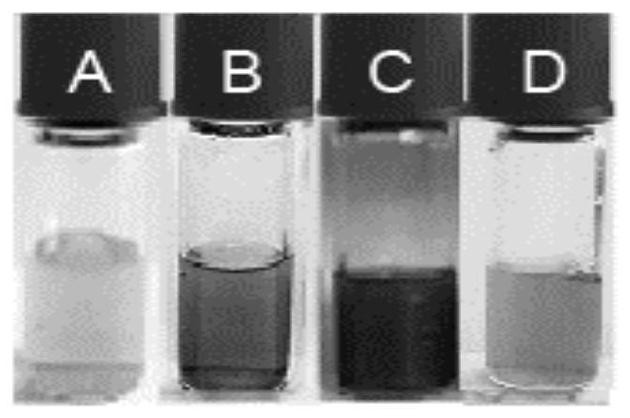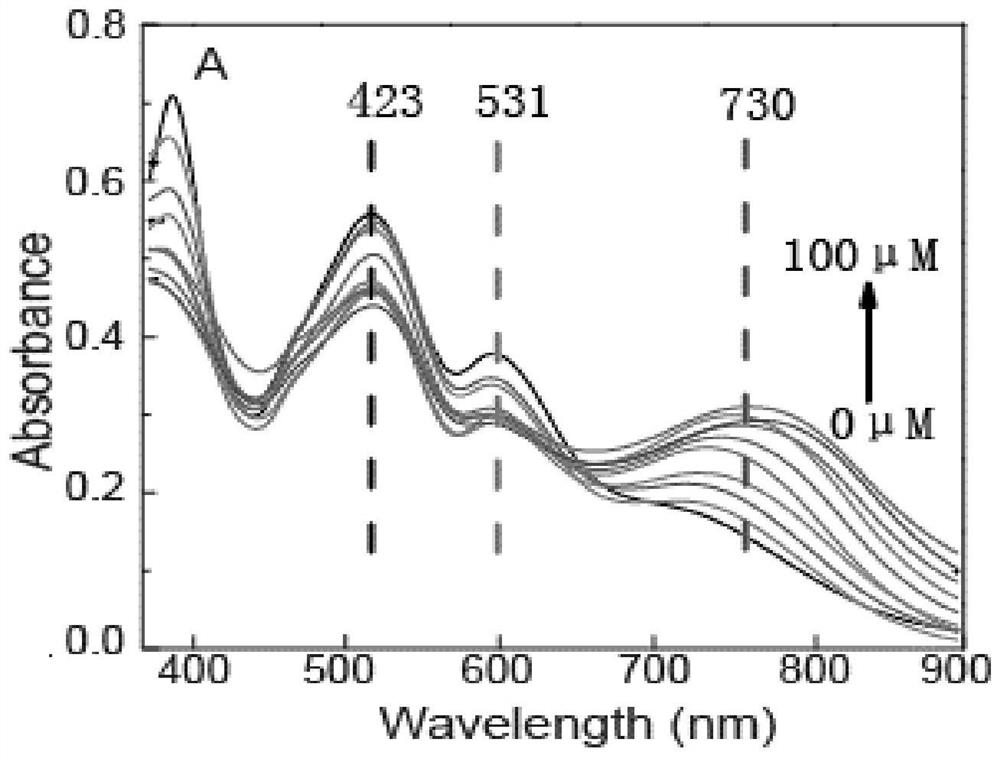Colorimetric and surface-enhanced Raman dual-sensing analysis method and reagent for copper ions
A technology of surface enhancement and analysis method, applied in the field of copper ion detection, can solve the problems of poor control of reaction temperature, limited application, strong reduction performance of sodium borohydride, etc., and achieves rapid colorimetric qualitative analysis, detection sensitivity, and sample dosage. less effect
- Summary
- Abstract
- Description
- Claims
- Application Information
AI Technical Summary
Problems solved by technology
Method used
Image
Examples
Embodiment 1
[0040] Preparation of GNPs-AgNPs structure
[0041] (1) Preparation of gold nanoparticles
[0042] Add 100ml of water and 1ml of 10% HAucl to the three-neck flask 4 Heat to boiling, then add 1ml% sodium citrate, boil for 30min and the solution turns wine red, stop heating, cool to room temperature, filter with 0.45μM microporous membrane, centrifuge at 6000r for 10min three times, concentrate and enrich gold nanoparticles.
[0043] (2) Preparation of 4-mercaptopyridine modified gold nanoparticles
[0044] Take 10ul of 1mM 4-mercaptopyridine ethanol solution and 1ml of gold nanoparticle solution and incubate at room temperature for 6h, and centrifuge at 5000r for 3min to remove unbound 4-mercaptopyridine. The centrifuged precipitate was dispersed with 1 ml of ultrapure water. The obtained 4-mercaptopyridine-modified gold nanorod dispersion was stored at 4°C.
[0045] (3) Preparation of spherical silver nanoparticles
[0046] Slowly add 40ml of glycerin and 60ml of water in...
Embodiment 2
[0052] Cu 2+ Complexation Test of GNPs-AgNPs Probe Molecules
[0053] (1)Cu 2+ Complexation of GNPs-AgNPs probe molecules
[0054] A series of concentrations of copper ions were added to the implementation case 1 to assemble GNPs-Cu 2+ -The color change of the AgNPs system before and after assembly is as follows: figure 1 shown.
[0055] (2) Raman detection of copper ions
[0056] The present invention uses an ultraviolet-visible absorption spectrometer to measure the color change after adding different concentrations of copper ions (0-100μM). figure 2 It is the change of the UV response spectrum of the GNPs-AgNPs probe molecule with the increase of the copper ion concentration in Example 1. figure 2 It is shown that the ultraviolet absorption peaks of AgNPs and GNPs appear at 423nm and 531nm respectively, and as the concentration of copper ions increases, copper ions and probe molecules chelate to make nanoparticles aggregate at 730nm and a new peak appears, image 3...
Embodiment 3
[0060] Actual water and soil sample testing
[0061] Figure 6 Schematically provides a flow chart for the detection of copper ions in water samples and soil samples according to an embodiment of the present invention, the detection method includes the following steps:
[0062] (1) Prepare gold nanoparticles, the steps are the same as in Example 1;
[0063] (2) Prepare gold nanoparticles modified by 4-mercaptopyridine, the steps are the same as in Example 1;
[0064] (3) preparing silver nanoparticles, the steps are the same as in Example 1;
[0065] (4) prepare silver nanoparticles modified with 4-mercaptobenzoic acid, the steps are the same as in Example 1;
[0066] (5) Gold nanoparticles modified by 4-mercaptopyridine and silver nanoparticles modified by 4-mercaptobenzoic acid are mixed, and the steps are the same as in Example 1;
[0067] (6) 4-Mercaptopyridine-modified gold nanoparticles and 4-mercaptobenzoic acid-modified silver nanoparticles are added to the mixed s...
PUM
| Property | Measurement | Unit |
|---|---|---|
| Excitation wavelength | aaaaa | aaaaa |
Abstract
Description
Claims
Application Information
 Login to View More
Login to View More - Generate Ideas
- Intellectual Property
- Life Sciences
- Materials
- Tech Scout
- Unparalleled Data Quality
- Higher Quality Content
- 60% Fewer Hallucinations
Browse by: Latest US Patents, China's latest patents, Technical Efficacy Thesaurus, Application Domain, Technology Topic, Popular Technical Reports.
© 2025 PatSnap. All rights reserved.Legal|Privacy policy|Modern Slavery Act Transparency Statement|Sitemap|About US| Contact US: help@patsnap.com



